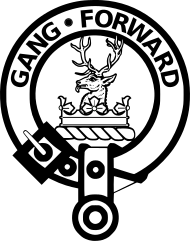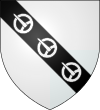Clan Stirling
| Clan Stirling | |||
|---|---|---|---|

Crest: Issuing out of an antique coronet Or a hart's head couped Azure
|
|||
| Motto | Gang Forward | ||
| Profile | |||
| Region | Lowlands | ||
| District | East Dunbartonshire Stirlingshire Perthshire | ||
| Chief | |||
 |
|||
| Francis Stirling of Cadder | |||
| Chief of the Name and Arms of Stirling | |||
| Seat | Oakley Street, London SW3 | ||
| Historic seat | Cadder House | ||
|
|||
|
|||
Clan Stirling is a Lowland Scottish clan.
The Scottish town of Stirling and Stirling Castle lie at the crossroads of Scotland and this could account for the derivation of the name which means place of strife.
Appearing in a charter of David I of Scotland in around 1147 is Thoraldus who held the lands of Cadder. His descendant was Alexander de Strivelyn, fifth Laird of Cadder who died in 1304.
During the Wars of Scottish Independence Alexander's heir, Sir John de Strivelyn, was killed at the Battle of Halidon Hill in 1333.
The grandson of Sir John de Strivelyn was Sir William who had two sons. The succession passed through his eldest son, also called William, for four generations. After this it passed to a grandson of the second son, Sir John de Strivelyn, third Laird of Cragernard. Sir John was the governor of the royal Dumbarton Castle and sheriff of Dumbartonshire.James I of Scotland appointed him as Comptroller of the Royal Household and armour bearer. He was knighted in 1430. His son, William, acquired from the Earl of Lennox the lands of Glorat. William also held Dumbarton Castle and this appointment passed to his son, George, who defended it for the Crown between 1534 and 1547. George fought at the Battle of Pinkie Cleugh and died of wounds received there.
In 1581 Malcom Kincaid of Clan Kincaid was killed by a Stirling of Glovat (Glorat).
George's great grandson was Sir Mungo Stirling of Glorat who was a staunch supporter of Charles I of England. In recognition of his bravery Charles knighted Sir Mungo. Sir Mungo's son was George Stirling who was created a Baronet of Nova Scotia in 1666.
...
Wikipedia
